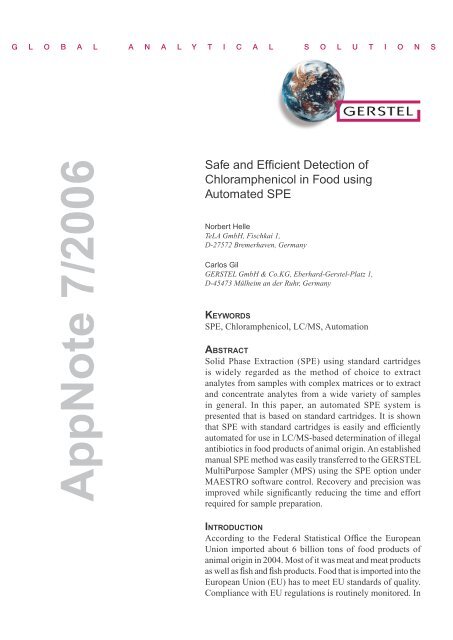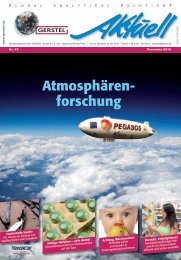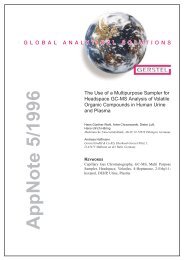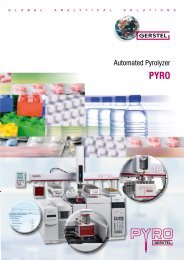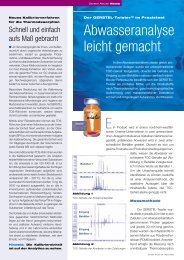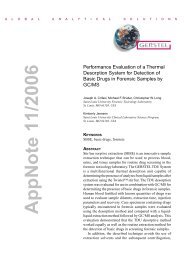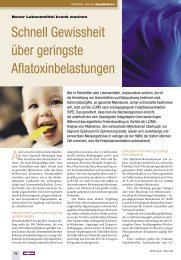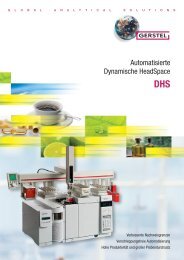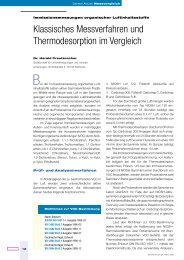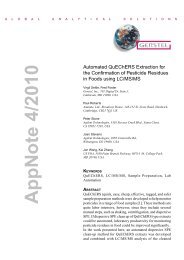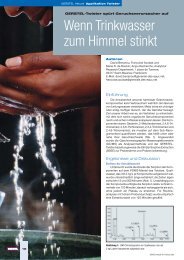2006/07 - Gerstel
2006/07 - Gerstel
2006/07 - Gerstel
You also want an ePaper? Increase the reach of your titles
YUMPU automatically turns print PDFs into web optimized ePapers that Google loves.
AppNote 7/<strong>2006</strong><br />
Safe and Effi cient Detection of<br />
Chloramphenicol in Food using<br />
Automated SPE<br />
Norbert Helle<br />
TeLA GmbH, Fischkai 1,<br />
D-27572 Bremerhaven, Germany<br />
Carlos Gil<br />
GERSTEL GmbH & Co.KG, Eberhard-<strong>Gerstel</strong>-Platz 1,<br />
D-45473 Mülheim an der Ruhr, Germany<br />
KEYWORDS<br />
SPE, Chloramphenicol, LC/MS, Automation<br />
ABSTRACT<br />
Solid Phase Extraction (SPE) using standard cartridges<br />
is widely regarded as the method of choice to extract<br />
analytes from samples with complex matrices or to extract<br />
and concentrate analytes from a wide variety of samples<br />
in general. In this paper, an automated SPE system is<br />
presented that is based on standard cartridges. It is shown<br />
that SPE with standard cartridges is easily and efficiently<br />
automated for use in LC/MS-based determination of illegal<br />
antibiotics in food products of animal origin. An established<br />
manual SPE method was easily transferred to the GERSTEL<br />
MultiPurpose Sampler (MPS) using the SPE option under<br />
MAESTRO software control. Recovery and precision was<br />
improved while significantly reducing the time and effort<br />
required for sample preparation.<br />
INTRODUCTION<br />
According to the Federal Statistical Office the European<br />
Union imported about 6 billion tons of food products of<br />
animal origin in 2004. Most of it was meat and meat products<br />
as well as fish and fish products. Food that is imported into the<br />
European Union (EU) has to meet EU standards of quality.<br />
Compliance with EU regulations is routinely monitored. In
the past, residues of illegal antibiotics have been found<br />
in food products of animal origin like honey, prawn<br />
or poultry as well as in animal feed. When nitrofurane<br />
antibiotics and the active compound chloramphenicol<br />
(CAP) were found it caused real upheaval.<br />
Chloramphenicol (Figure 1) is a broad-spectrum<br />
antibiotic that was extracted for the first time in 1947<br />
from the bacteria Streptomyces venezuelae and is now<br />
produced synthetically. CAP has excellent antibacterial<br />
and pharmacokinetic properties. The application<br />
in human medicine and animal health is strongly<br />
regulated: The use of CAP in clinical applications is<br />
only allowed after careful consideration and only for<br />
treatment of contagious diseases like typhus, dysentery,<br />
diphtheria or malaria. CAP is commonly used for pets<br />
however. Animals that will subsequently be used for<br />
food production have not been allowed to be treated<br />
with Chloramphenicol within the EU since 1994.<br />
O 2<br />
N<br />
OH<br />
CH<br />
CH<br />
NH<br />
CH 2<br />
Figure 1. Structure of Chloramphenicol.<br />
OH<br />
CO CHCl 2<br />
According to the Food and Agriculture Organization<br />
of the United Nations (FAO) CAP is suspected of<br />
causing genetic damage in human cells and of being<br />
a carcinogenic. Additionally it may be correlated to<br />
irreversible damage of the blood-forming cells of the<br />
bone marrow. Up to now no relationship between<br />
dosis and effect could be determined which led to<br />
the strict prohibition of CAP for the treatment of<br />
animals in Europe. Any confirmed positive finding<br />
led to the immediate withdrawal of the product from<br />
the market.<br />
In literature, radioimmunological and enzymatic<br />
methods have been described for determination of<br />
chloramphenicol. In practice, only mass spectrometric<br />
methods are appropriate. GC/MS in chemical ionization<br />
(CI) mode as well as LC/MS enable laboratories to<br />
achieve the required low detection limits.<br />
The sensitivity of a method strongly depends on<br />
the sample preparation. Even for highly selective LC-<br />
MS/MS methods a high matrix background can lead<br />
to inadequate quantification. However, this can be<br />
handled by spiking the matrix. In addition to liquidliquid<br />
extraction, SPE using cartridges is the sample<br />
preparation method of choice when analyzing samples<br />
with a high matrix load. For fatty samples or complex<br />
finished products with non-polar matrices, the C18<br />
cartridge is the best choice. However this manual<br />
procedure is time-consuming and labor-intensive.<br />
The target of this study was to optimize sample<br />
preparation for CAP analysis and automate the steps<br />
to minimize the time required and improve the quality<br />
of results. The GERSTEL MPS autosampler with an<br />
automated SPE option as shown in figure 2 was used<br />
for this work.<br />
Figure 2. GERSTEL MPS with integrated SPE option, solvent reservoir and injection valve.<br />
AN/<strong>2006</strong>/<strong>07</strong> - 2
The manual SPE method was automated using the<br />
GERSTEL MPS SPE option (Figure 3). The automated<br />
method gave slightly better results than a highly<br />
experienced manual operator.<br />
way that no dead volume is left between the packing<br />
and the cap itself. The sample/solvent is loaded onto<br />
the cartridge under positive pressure using a syringe,<br />
ensuring optimal control over the automated elution<br />
steps.<br />
All required steps are selected by mouse-click from<br />
a pull-down menu using the PrepBuilder function of<br />
the GERSTEL MAESTRO software. The SPE process<br />
was set up as followed:<br />
1. Conditioning of the SPE cartridge with 4 mL<br />
methanol, followed by 4 mL of water<br />
2. Sample introduction (4 mL of the extract)<br />
3. Rinsing the SPE phase with 1 mL water and 4 mL<br />
methanol/water mixture (1:10)<br />
4. Elution of the analytes with 3 mL methanol/water<br />
mixture (1:1)<br />
Figure 3. MPS SPE option with rack for 3 mL standard<br />
SPE cartridges (left) and elution unit with cartridge<br />
holder (right). The MPS is shown while transporting<br />
the cartridge to waste position. 1 mL, 3 mL and 6 mL<br />
standard cartridges can be used.<br />
EXPERIMENTAL<br />
In this study, the focus was on the determination of<br />
CAP in prawns. This method can be easily adapted to<br />
other food products of animal origin. A 100 g sample of<br />
untreated muscle tissue is homogenized using a mixer.<br />
10 mL ethylacetate and Chloramphenicol-d5 (internal<br />
standard) are added to a 5 g aliquot of the treated<br />
sample. The sample is again mixed using an Ultra<br />
Turrax and subsequently centrifuged. The liquid phase<br />
is recollected and concentrated in a rotary evaporator.<br />
The residue is diluted with methanol/water (1:10) and<br />
is then ready for the SPE process.<br />
A standard 3 mL C18 SPE cartridge (M&N C18<br />
endcapped) with 500 mg solid phase was used. In<br />
the MPS SPE option, cartridges are capped in such a<br />
These steps lead to an enrichment of the analyte by<br />
a factor of 1.3. As a second concentration step the<br />
MPS is able to evaporate the solvent using a flow<br />
of inert gas while keeping the eluate at a specified<br />
temperature. In this study a second concentration factor<br />
of 5 (evaporating to 600 μL) and 10 (evaporating to<br />
300μL) were tested.<br />
From a chromatographic point of view<br />
Chloramphenicol is not a big challenge. Due to its<br />
semi polar character CAP can be separated easily<br />
from the matrix using a standard reversed phase (RP)<br />
chromatographic column. For this work a Phenomenex<br />
maxRP column (250 x 2.1 mm) was used because this<br />
column exhibits low bleeding, improving the detection<br />
limit of the method. Isocratic elution was performed<br />
using a mixture of 0.005 M ammonium formate<br />
adjusted with ammonia to pH 8.5 and acetonitrile. The<br />
mobile phase was adjusted to give a retention time of<br />
about 7.5 min for CAP. The internal standard (CAP- d5)<br />
has a slightly shorter retention time due to the isotope<br />
effect. The whole chromatographic run including<br />
rinsing and equilibration takes at most 25 minutes.<br />
During this time the automated SPE (duration about<br />
15 min) for the following sample can be performed in<br />
order to maximize throughput. Using this method, 50<br />
analyses can be performed in one day.<br />
For the detection (Figures 4 and 5) an Agilent 1100<br />
MSD 1956B as well as an Agilent 1100 MSD Ultra plus<br />
Ion Trap were used. Both systems used identical HPLC<br />
methods and columns. The detection was performed<br />
in negative ESI mode.<br />
AN/<strong>2006</strong>/<strong>07</strong> - 3
20000<br />
Scan<br />
A<br />
10000<br />
10000<br />
0<br />
20000<br />
10000<br />
0<br />
20000<br />
10000<br />
0<br />
2 4 6<br />
8 10 12 14<br />
SIM 321.1<br />
2 4 6<br />
8 10 12 14<br />
SIM 326.1<br />
2 4 6<br />
8 10 12 14<br />
SIM 323.1 / 328.1<br />
2 4 6<br />
8 10<br />
Quantifier<br />
Quantifier<br />
Qualifier<br />
12 14<br />
Figure 4. Simultaneously recorded LC/MS chromatogram traces of a prawn sample spiked with 2.0 μg CAP/<br />
kg: (A) scan 100–500 amu to check for impurities, (B) SIM at 321.1 amu as quantifier for CAP, (C) SIM at<br />
326.1 amu as quantifier for CAP-d5 and (D) SIM at 323.1 and 328.1 amu as qualifiers for CAP and CAP-d5<br />
respectively. The Agilent MSD 1100 Single Quad is able to achieve a LOD of 0.05 μg/kg for CAP (Signal-tonoise<br />
= 10:1).<br />
min<br />
B<br />
min<br />
C<br />
min<br />
D<br />
min<br />
Although the Single-Quad-System in combination<br />
with the automated sample preparation achieves an<br />
adequate detection limit, the ion trap can go to even<br />
lower detection limits. Ion traps can perform MS/MS<br />
using the full fragmentation spectrum in contrast to<br />
triple quadrupole instruments. This capability can be<br />
used to select the best transition in the extracted ion<br />
mode. In this case the transitions 321 – 257 amu for<br />
CAP and 326 – 262 amu for CAP-d5 were selected<br />
(Figure 5).<br />
AN/<strong>2006</strong>/<strong>07</strong> - 4
Abundance<br />
A<br />
100000<br />
Scan<br />
50000<br />
0<br />
4000<br />
2 4 6<br />
8 10<br />
(min)<br />
B<br />
3000<br />
2000<br />
EIC 321.1 - 257.1<br />
1000<br />
0<br />
10000<br />
8000<br />
2 4 6<br />
8 10<br />
(min)<br />
C<br />
6000<br />
4000<br />
EIC 326.1 - 262.1<br />
2000<br />
0<br />
2 4 6<br />
8 10<br />
(min)<br />
Figure 5. LC/MSMS chromatograms of CAP and CAP-d5 using the Agilent 1100 MSD Ultra plus Ion Trap.<br />
(A) Scan, (B) extracted ion chromatogram for the 321.1 – 257.1 amu transition (CAP) and (C) the transition<br />
of 326.1 – 262.1 amu (CAP-d5).<br />
AN/<strong>2006</strong>/<strong>07</strong> - 5
RESULTS AND DISCUSSION<br />
Evaporative concentration of the eluate by a factor<br />
of 10 after the SPE process enables the analyst to<br />
achieve a very good LOD of 0.01 μg/kg for CAP<br />
using the ion trap system. The injected amount at this<br />
concentration is equivalent to 1 pg of CAP (Figure<br />
6). Despite concentrating the eluate by a factor of 10<br />
no significant interference from the accompanying<br />
matrix is observed in the quantification thanks to the<br />
SPE cleanup. This was tested in further experiments<br />
using more complex matrices (e.g. prepared prawn<br />
with spices and garlic oil). No significant differences<br />
were observed compared to the results from pure prawn<br />
samples.<br />
257.0<br />
fragment<br />
parent<br />
321.0<br />
1 pg CAP<br />
fragmentation spectrum CAP<br />
2 4 6<br />
8<br />
Figure 6. Chromatogram of the 321.0 –257.1 transition; detection of 0.01 μg/kg CAP in prawns.<br />
10<br />
min<br />
Recovery and repeatability of manual SPE depends<br />
mainly on the human factor. The experience, knowledge<br />
and diligence of each individual laboratory technician<br />
has a big influence on the quality of results. Even minor<br />
errors can lead to major fluctuation in both recovery<br />
and repeatability. The use of the GERSTEL MPS with<br />
integrated SPE option shows that no fluctuations are<br />
observed when automating these steps. The excellent<br />
repeatability of the whole method (including extraction,<br />
sample preparation and LC/MS analysis) is visualized<br />
by a signal overlay of Chloramphenicol traces from<br />
six different samples (prawn samples spiked with<br />
2.0 μg/kg Chloramphenicol each) (Figure 7). The<br />
recovery and repeatability is nevertheless generally<br />
good. For CAP a standard deviation of 2.0 % for the<br />
automated and 2.2 % for the manual approach using<br />
a highly experienced technician was achieved. The<br />
recovery was 92.1 % (MPS) and 89.6 % (manual)<br />
respectively as can be seen in figure 8.<br />
AN/<strong>2006</strong>/<strong>07</strong> - 6
Abundance<br />
20000<br />
15000<br />
10000<br />
5000<br />
0<br />
6 7 8<br />
9<br />
Figure 7. Overlay of CAP traces from six different samples.<br />
min<br />
Response<br />
500000<br />
400000<br />
300000<br />
200000<br />
1<br />
manual<br />
recovery = 89.6 %<br />
RSD = 2.2 %<br />
MPS 3<br />
recovery = 92.1 %<br />
RSD = 2.0 %<br />
2 3 4 5<br />
CAP manual<br />
CAP MPS 3<br />
6 7 8<br />
Figure 8. Recovery and repeatability for the determination<br />
of Chloramphenicol in prawns with manual and automated<br />
sample preparation.<br />
CONCLUSIONS<br />
This example shows that the use of SPE<br />
for sample preparation enables sensitive<br />
detection of pharmaceutical residues even<br />
in complex matrices. Sample throughput<br />
can be significantly improved when<br />
automating the sample preparation steps<br />
using the GERSTEL MPS with integrated<br />
SPE module while maintaining or improving<br />
recovery and repeatability compared with<br />
the manual method. SPE sample preparation<br />
using the MPS easily accomplished reaching<br />
the MDL (Minimum Detection Limit) for<br />
Chloramphenicol of 0.3 μg/kg mandated<br />
by the EU. Using automated evaporative<br />
concentration and Ion Trap detection the<br />
LOD can be lowered to 0.01 μg/kg. Despite<br />
the concentration steps no significant matrix<br />
effect is observed thanks to the SPE sample<br />
preparation.<br />
AN/<strong>2006</strong>/<strong>07</strong> - 7
GERSTEL GmbH & Co. KG<br />
Eberhard-<strong>Gerstel</strong>-Platz 1<br />
D-45473 Mülheim an der Ruhr<br />
Germany<br />
+49 (0) 208 - 7 65 03-0<br />
+49 (0) 208 - 7 65 03 33<br />
gerstel@gerstel.com<br />
www.gerstel.com<br />
GERSTEL Worldwide<br />
GERSTEL, Inc.<br />
701 Digital Drive, Suite J<br />
Linthicum, MD 21090<br />
USA<br />
+1 (410) 247 5885<br />
+1 (410) 247 5887<br />
sales@gerstelus.com<br />
www.gerstelus.com<br />
GERSTEL AG<br />
Wassergrabe 27<br />
CH-6210 Sursee<br />
Switzerland<br />
+41 (41) 9 21 97 23<br />
+41 (41) 9 21 97 25<br />
gerstel@ch.gerstel.com<br />
www.gerstel.ch<br />
GERSTEL K.K.<br />
1-3-1 Nakane, Meguro-ku<br />
Tokyo 152-0031<br />
SMBC Toritsudai Ekimae Bldg 4F<br />
Japan<br />
+81 3 5731 5321<br />
+81 3 5731 5322<br />
info@gerstel.co.jp<br />
www.gerstel.co.jp<br />
GERSTEL LLP<br />
Level 25, North Tower<br />
One Raffles Quay<br />
Singapore 048583<br />
+65 6622 5486<br />
+65 6622 5999<br />
SEA@gerstel.com<br />
www.gerstel.com<br />
GERSTEL Brasil<br />
Av. Pascoal da Rocha Falcão, 367<br />
04785-000 São Paulo - SP Brasil<br />
+55 (11)5665-8931<br />
+55 (11)5666-9084<br />
gerstel-brasil@gerstel.com<br />
www.gerstel.com.br<br />
Information, descriptions and specifications in this<br />
Publication are subject to change without notice.<br />
GERSTEL, GRAPHPACK and TWISTER are registered<br />
trademarks of GERSTEL GmbH & Co. KG.<br />
© Copyright by GERSTEL GmbH & Co. KG<br />
Awarded for the<br />
active pursuit of<br />
environmental sustainability


